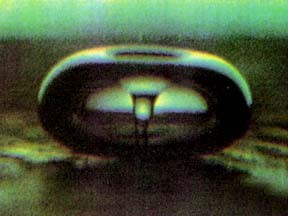What is Ultrasonic Cleaning?
Ultrasonic Cleaning, or Ultrasonic Cavitation, is the momentary creation of vacuum “tears” commonly referred to as “bubbles” in the fluid which immediately and violently implode to produce millions of microscopic jets of liquid which gently scrubs the parts which are submerged in the tank. In addition, local temperatures near this activity has been shown to be as high as 10,000 degrees Celsius, and the pressure produced may be as high as 10,000 PSI. These tears or cavities are created tens of thousands of times each second to gently remove contaminants without damage, as long as the ultrasonic frequency selected is correct for the cleaning application. At 80kHz, cavities are generated 80,000 times each second.
The photograph at the right depicts an imploding cavity, and clearly demonstrates the process. Notice that the top of the cavity is folding inward and producing a jet of liquid which can be seen down the center of the cavity. Millions of times each minute, the surface of any parts submerged in the bath are being attacked by these implosions, although the cleaning action produced is rather gentle.
Although these cavities are produced by the millions, the distribution of these cavities is determined by the ultrasonic frequency in operation. Every ultrasonic cleaning system produces a cleaning action that is distributed as a series of equidistant bands of activity. These bands are known as “standing waves”, and cleaning action between standing waves is only a fraction of the energy which
is produced at a standing wave location. This is why selection of the appropriate ultrasonic frequency is so important to developing an effective cleaning process. The frequency selected must produce a distribution of cavitation which ensures that the entire part is successfully cleaned. More information can be found in the Technical Info drop-down menu above under “Frequency Selection“.
Sound waves are composed of 2 actions; and expansion cycle during which the liquid molecules are being pulled apart, and a compression cycle, during which the molecules are being compressed. If the expansion cycle of the wave has enough energy to overcome the forces which hold the molecules of liquid together, a cavity is produced. Immediately following the expansion cycle, the compression cycle follows, rapidly compressing the cavities created. The photograph shown above indicates that the compression cycle has begun to implode the cavity.
What affects ultrasonic cleaning?
The ultrasonic frequency in use determines how often cavities are produced per unit of time, the size of the cavity, the distribution of cleaning action, and the force behind cavitational implosion. Since an 80kHz system has much shorter compression/expansion cycles, cavities that are produced are smaller since there is less time to increase the size of the cavity during the expansion cycle. When compression cycles follow, the duration of compression is also shorter than lower frequency systems, yielding a more gentle cleaning action.
Movement of the cleaning fluid during ultrasonic cavitation will drastically reduce ultrasonic cavitation until the circulation is reduced to some degree. The smaller the ultrasonic tank, the higher the ultrasonic frequency, or higher the watt/gallon density of the system, the faster the system can recover from fluid motion. This is the primary reason why filtration systems are typically not operated when parts are being ultrasonically cleaned. More information on this phenomenon can be found in the Technical Info drop-down menu under Fluid Circulation.
The amount of dissolved gasses within the fluid will also affect ultrasonic cavitation. Dissolved gasses are a compressible medium which act as a “shock absorber” to ultrasonic energy being emitted. Although cavitation will be present, its power is reduced. Fluids which have been degassed produce 25-50% more cleaning effect than fluids containing dissolved gasses. Fortunately, the ultrasonic system will automatically degas the cleaning fluid, the speed of which will be determined by the volume of liquid in the tank, and the watt/gallon power density of the system. More information regarding degassing can be found in the Technical Info under Degassing of Fluid.
Basket designs can also have an enormous affect on the cavitation generated. Although baskets for use in an ultrasonic cleaning system are typically manufactured of wire mesh, the size of the mesh can drastically affect ultrasonic cavitation. Generally, the tighter the mesh, the more destructive the basket will be for ultrasonic cleaning. Ultrasonic waves are distorted by these designs which drastically reduces the scrubbing action produced. Baskets which are manufactured of plastics should never be used in an ultrasonic cleaning system unless absolutely required. Most plastics completely absorbs the energy being emitted by the transducers, preventing cavitation on the opposite side of the plastic wall. If plastics are required, keep the material as thin as possible, and the design of the basket should be as “open” as possible. In most cases, plastics are required to prevent part damage. If this is the case, one must consider to only soften the contact points between the materials being cleaned and the basket or parts fixture.
Temperature of the cleaning fluid will also affect ultrasonic cavitation. As temperatures increase, the cavities immediately fill with liquid vapor which cushions the implosive action which cleans the parts. Cavitation will degrease at temperatures above 65% of the boiling point of the fluid. However, since the effectiveness of some cleaning agents can overcome this loss at higher temperatures, it is not un-common to find ultrasonic cleaning systems operating at well over 65% of the boiling point of the fluid. More information regarding temperature and its effect on ultrasonic cleaning can be found in the Technical Info drop-down menu above under Temperature Effects.
The cleaning agents selected for a given cleaning application will change the distribution of ultrasonic energy, and the power of cavitational implosive force. While some cleaning agents will tend to even out the energy distribution and enhance implosive force, some agents will reduce or completely eliminate effective ultrasonic cavitation. The cleaning agents selected must consider how the agent will affect ultrasonic cavitation in the tank.


